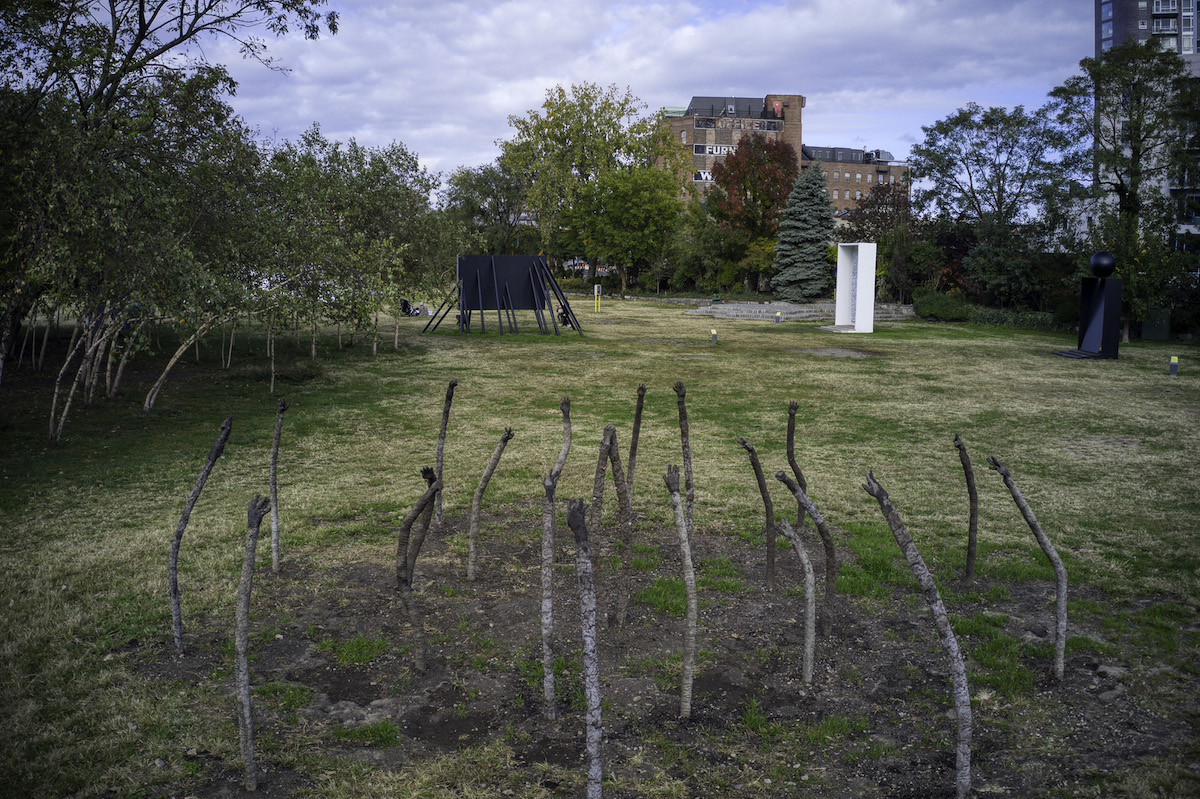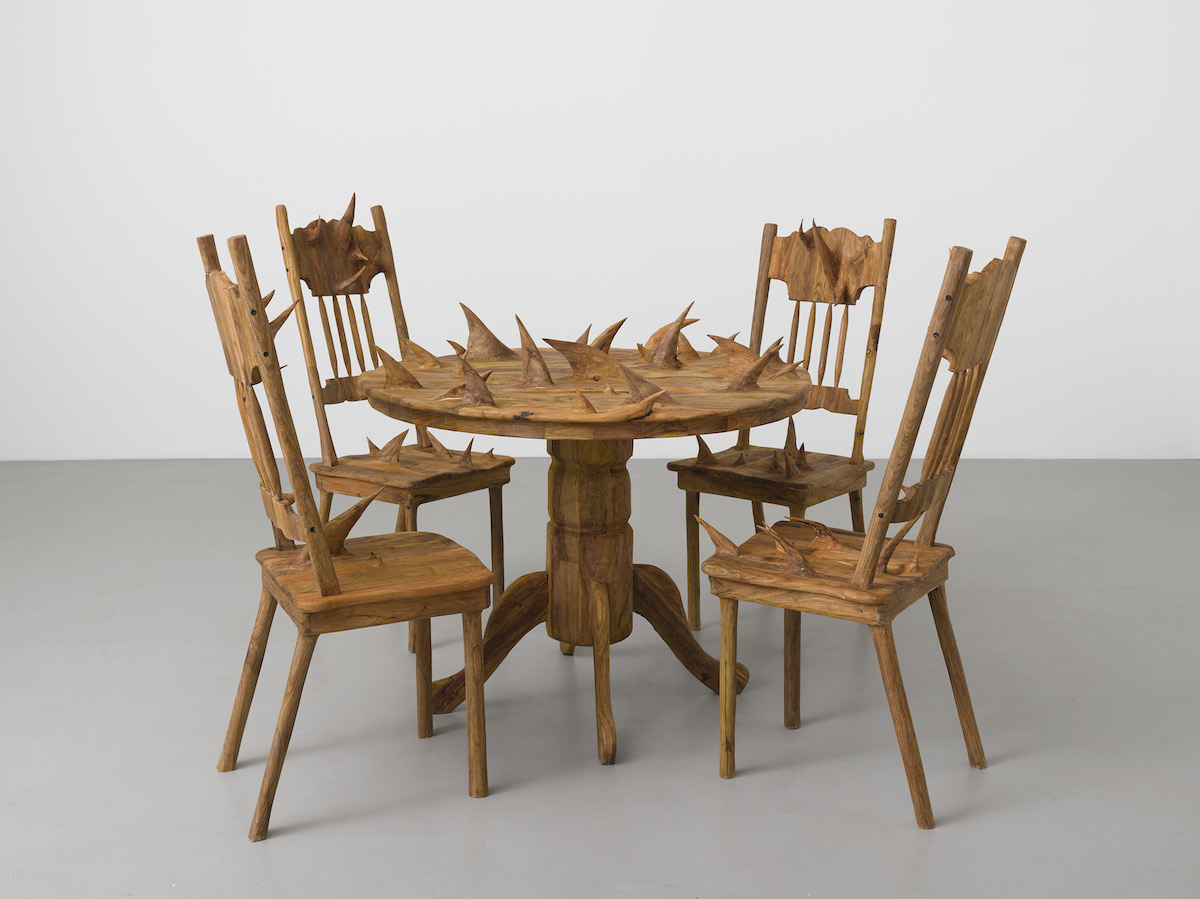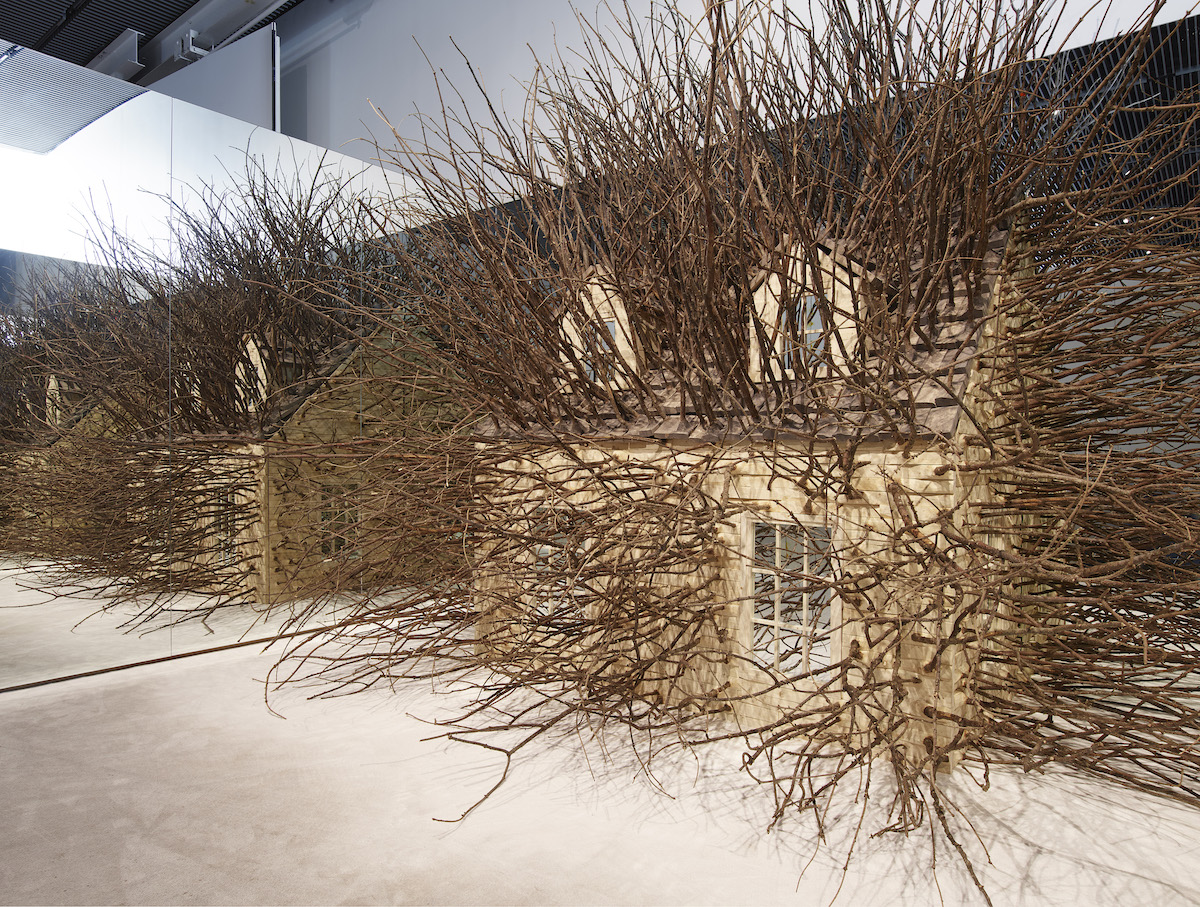Our apocalypse is self-inflicted. We gouge at our wounds in acts of self-harm. Our collective anxiety festers as disaster takes hold, yet we remain paralyzed by fear, unable to face our reality. Implausible flames dance on the ocean’s surface; acres of California mountains are scorched black; storms terrorize and devastate our cities. The environmental crisis is no longer looming overhead, it is no longer an abstraction—an unsettling shadow we choose to ignore or hide from—it’s here, screaming!
Artists Max Hooper Schneider, Hugh Hayden, and Kiyan Williams consider the ecological horrors of our past, present and future. These artists explore the intersection of ecology and horror, examining the ways in which “eco-horror” speaks to our precarious and terrifying reality. Monsters take shape in many forms as we explore our house of horrors.
Throughout art history, terror has been represented in the mysterious and untamable presence of Mother Nature. Modernist notions of “the sublime” often inspired feelings of fear and dread in the face of nature’s beauty, most notably in the sublime landscape paintings of Caspar David Friedrich and William Turner.
In 1991, Damien Hirst assumed the role of God when he submerged a shark in a tank of formaldehyde. The Physical Impossibility of Death in the Mind of Someone Living attempts to suspend a moment of terror—the petrified shark grins menacingly upon spectators—embodying the false and dangerous idea that humans can control nature. Hirst asserts dominance over one of the most feared animals, laughing in the face of Nature. Perhaps our modern era’s “sublime”-terror should be redefined by ceaseless colonization and the harrowing conditions of late capitalism. Dread resides in the banal as well as our narcissistically gluttonous systems of consumption. Drunk on greed and ego, we have mistaken ourselves for gods, when we are actually monsters.

“Hammer Projects: Max Hooper Schneider,” installation view, Hammer Museum, Los Angeles, Sept 21,2019–Feb 2, 2020; ©Max Hooper Schneider and courtesy of High Art, Paris and Maureen Paley, London, photo by Jeff McLane.
Max Hooper Schneider (b. 1982, Los Angeles) imagines grotesque and ruinous landscapes of a human-centered world. He explores the complex interdependence between human and nonhuman life, between organic and artificial materials. Hooper Schneider’s mutations take shape in the form of terrariums and site-specific installations. For his large-scale installation at the Hammer Museum in 2019, Hooper Schneider imagined a dystopian junkyard in which organic and artificial materials coexist in a menacing entanglement. A plastic Costco size container of cheese puffs sits atop a mountain of cacti. A mangled shopping cart is engulfed by vegetation, its wheels reaching out as if gasping for air. Sneakers, toys and costume jewelry—once fleeting objects of desire—form a petrified litter of decay. Hooper Schneider’s defunct objects signify the headstones of late capitalism and their siting, nature’s ultimate triumph over humankind.
The inextricable bond between nature and culture, linked in a complex and tentacled web is considered in Hooper Schneider’s works. His background in landscape architecture and marine biology led him to challenge empirical scientific disciplines through art-making. He brings together concepts that have now become absurdly oppositional—nature and culture—as he examines survival on multiple levels; micro and macro, human and nonhuman. He asks, Who will inherit the earth? Will plastic relics of “human progress” haunt the planet when we finally perish?

Kiyan Williams, Reaching Towards Warmer Suns, 2020, Image credit: Mark DiConzi
Kiyan Williams (b. 1990, Newark) is a multidisciplinary artist who frequently utilizes what has now become their signature medium: soil. The earth is where we bury our dead, grow our food—a material of decay, rebirth and growth. Soil contains so many histories; some perhaps lost forever, and others lying just beneath the surface, ready to emerge. Their work exists between the horrific and the cathartic.
Their large-scale sculpture Reaching Towards Warmer Suns (2020) is a group of 20 arms springing up from the earth and reaching towards the heavens, not unlike scenes of the dead rising from their graves found in countless horror movies. The hands make defiant fists, raise middle fingers, and gesture urgently, almost begging to be released from the earth of which they are composed and contained. These disembodied limbs are at once eerie, joyful and defiant; they recall the horrendous traumas of enslaved Africans, kidnapped and forced onto American soil, stripped of their identities, families and cultures. Standing more than six-feet tall, the arms are visceral, tragic and hopeful.

Kiyan Williams, Dirt Eater Installation view, In Practice: Other Objects, SculptureCenter, New York, 2019, Image Credit: Kyle Knodell
In their video piece Dirt Eater (2019) Williams wears a steel patinated punishment mask—a device once forced onto enslaved people who practiced geophagy (dirt-eating). As they remove the mask from against their mouth, it pulls at their hair,—they wince. They lick, suck and kiss the dirt figure in front of them, expressing lust and disgust as they chew and swallow the thick brown paste. They smear what resembles both mud and feces across their mouth, eliciting a response of attraction-repulsion.
Williams’ work evokes the horrors and violence inflicted upon enslaved ancestors. This violence has solid roots in American soil, passed down through generations like a festering wound that refuses to heal. Williams’ haunting imagery confronts the colonialist atrocities embedded within the American landscape and upon which modern American capitalist society is built. Blood has seeped into the lithosphere and absorbed into the landscape. Williams’ work acts as a reminder of the violence embedded in the very ground we walk on, but also functions as a form of liberation from the traumatic shackles of the past.

Hugh Hayden, America, 2018. Sculpted mesquite (Prosopis glandulosa) on plywood © Hugh Hayden. Courtesy Lisson Gallery
New–York-based artist Hugh Hayden (b. 1983, Dallas) investigates our connection to the natural world, and the ways in which trees and organic materials carry traces of memory, survival and exploitation. For his 2018 show at Lisson Gallery in New York, Hayden’s carved objects of domesticity embodied the fantasy of the American Dream. A dining table, a picket fence, a crib and a stroller stand unusable. The wood’s smooth yet spiny skin seems threatening. What should carry feelings of comfort and safety instead summons danger and fear, suggesting the violent price of the American Dream. Hayden sharply questions who is provided the opportunity to attain ownership and safety in America. His large-scale installation titled “Hedges,” exhibited at The Shed in New York in 2019, depicts an archetypal American home. Branches jut out ferociously from the pores of the wooden frame, alluding to the unruliness of nature and piercing the surrounding space. Throughout his work, Hayden uses environmental issues and organic materials to speak about his personal experience as a Black man in America.
Hayden exposes our complex interactions with the natural environment and the ways in which systems of oppression are tangled up in history, politics, economics and just about every facet of life. He explores multi-layered, multi-temporal, multi-species ecologies. America remains haunted by racist systems that condition and perpetuate the endless exploitation of bodies, land and resources. We exist in a constant struggle to respond to and define our relationship with the environment and each other.
As our collective home continues to perish, we might ask: who lives and who dies? What kind of radical transformation will enable cooperation and collaboration over dominance and control? A collective exorcism? Can we face our demons? How can the horrors of our reality help develop strategies of survival (for humans and nonhumans alike)? Until then, we remain afraid, very afraid.


